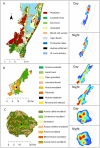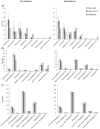Physiological stress and refuge behavior by African elephants
- PMID: 22384079
- PMCID: PMC3284500
- DOI: 10.1371/journal.pone.0031818
Physiological stress and refuge behavior by African elephants
Abstract
Physiological stress responses allow individuals to adapt to changes in their status or surroundings, but chronic exposure to stressors could have detrimental effects. Increased stress hormone secretion leads to short-term escape behavior; however, no studies have assessed the potential of longer-term escape behavior, when individuals are in a chronic physiological state. Such refuge behavior is likely to take two forms, where an individual or population restricts its space use patterns spatially (spatial refuge hypothesis), or alters its use of space temporally (temporal refuge hypothesis). We tested the spatial and temporal refuge hypotheses by comparing space use patterns among three African elephant populations maintaining different fecal glucocorticoid metabolite (FGM) concentrations. In support of the spatial refuge hypothesis, the elephant population that maintained elevated FGM concentrations (iSimangaliso) used 20% less of its reserve than did an elephant population with lower FGM concentrations (Pilanesberg) in a reserve of similar size, and 43% less than elephants in the smaller Phinda reserve. We found mixed support for the temporal refuge hypothesis; home range sizes in the iSimangaliso population did not differ by day compared to nighttime, but elephants used areas within their home ranges differently between day and night. Elephants in all three reserves generally selected forest and woodland habitats over grasslands, but elephants in iSimangaliso selected exotic forest plantations over native habitat types. Our findings suggest that chronic stress is associated with restricted space use and altered habitat preferences that resemble a facultative refuge behavioral response. Elephants can maintain elevated FGM levels for ≥ 6 years following translocation, during which they exhibit refuge behavior that is likely a result of human disturbance and habitat conditions. Wildlife managers planning to translocate animals, or to initiate other management activities that could result in chronic stress responses, should consider the potential for, and consequences of, refuge behavior.
Conflict of interest statement
Figures





Similar articles
-
Physiological stress responses in wild Asian elephants Elephas maximus in a human-dominated landscape in the Western Ghats, southern India.Gen Comp Endocrinol. 2018 Sep 15;266:150-156. doi: 10.1016/j.ygcen.2018.05.009. Epub 2018 May 17. Gen Comp Endocrinol. 2018. PMID: 29777687
-
Conservation outside protected areas and the effect of human-dominated landscapes on stress hormones in Savannah elephants.Conserv Biol. 2013 Jun;27(3):569-75. doi: 10.1111/cobi.12061. Conserv Biol. 2013. PMID: 23692020
-
Differing physiological and behavioral responses to anthropogenic factors between resident and non-resident African elephants at Mpala Ranch, Laikipia County, Kenya.PeerJ. 2020 Sep 28;8:e10010. doi: 10.7717/peerj.10010. eCollection 2020. PeerJ. 2020. PMID: 33062433 Free PMC article.
-
Population and individual elephant response to a catastrophic fire in Pilanesberg National Park.PLoS One. 2008 Sep 17;3(9):e3233. doi: 10.1371/journal.pone.0003233. PLoS One. 2008. PMID: 18797503 Free PMC article.
-
Monitoring and controlling ovarian activity in elephants.Theriogenology. 2018 Mar 15;109:42-47. doi: 10.1016/j.theriogenology.2017.12.009. Epub 2017 Dec 13. Theriogenology. 2018. PMID: 29287954 Review.
Cited by
-
Knowledge transmission, culture and the consequences of social disruption in wild elephants.Philos Trans R Soc Lond B Biol Sci. 2025 May;380(1925):20240132. doi: 10.1098/rstb.2024.0132. Epub 2025 May 1. Philos Trans R Soc Lond B Biol Sci. 2025. PMID: 40308137 Free PMC article. Review.
-
Reduced older male presence linked to increased rates of aggression to non-conspecific targets in male elephants.Proc Biol Sci. 2021 Dec 22;288(1965):20211374. doi: 10.1098/rspb.2021.1374. Epub 2021 Dec 22. Proc Biol Sci. 2021. PMID: 34933598 Free PMC article.
-
Habitat degradation and seasonality affect physiological stress levels of Eulemur collaris in littoral forest fragments.PLoS One. 2014 Sep 17;9(9):e107698. doi: 10.1371/journal.pone.0107698. eCollection 2014. PLoS One. 2014. PMID: 25229944 Free PMC article.
-
Welfare at Multiple Scales: Importance of Zoo Elephant Population Welfare in a World of Declining Wild Populations.PLoS One. 2016 Jul 14;11(7):e0158701. doi: 10.1371/journal.pone.0158701. eCollection 2016. PLoS One. 2016. PMID: 27415004 Free PMC article. No abstract available.
-
Identifying potential measures of stress and disturbance during a captive to wild African elephant reintegration.PLoS One. 2023 Oct 3;18(10):e0291293. doi: 10.1371/journal.pone.0291293. eCollection 2023. PLoS One. 2023. PMID: 37788241 Free PMC article.
References
-
- Romero LM. Physiological stress in ecology: lessons from biomedical research. Trends in Ecology and Evolution. 2004;19:249–255. - PubMed
-
- McEwen BS, Wingfield JC. The concept of allostasis in biology and biomedicine. Hormones and behavior. 2003;43:2–15. - PubMed
-
- Romero LM, Butler LK. Endocrinology of stress. International Journal of Comparative Psychology. 2007;20:85–95.
-
- Dickens MJ, Delehanty DJ, Romero LM. Stress: An inevitable component of animal translocation. Biological Conservation. 2010;143:1329–1341.
-
- Wingfield JC, Romenofsky M. Corticosterone and facultative dispersal in response to unpredictable events. Ardea. 1997;85:155–166.
Publication types
MeSH terms
Substances
LinkOut - more resources
Full Text Sources

